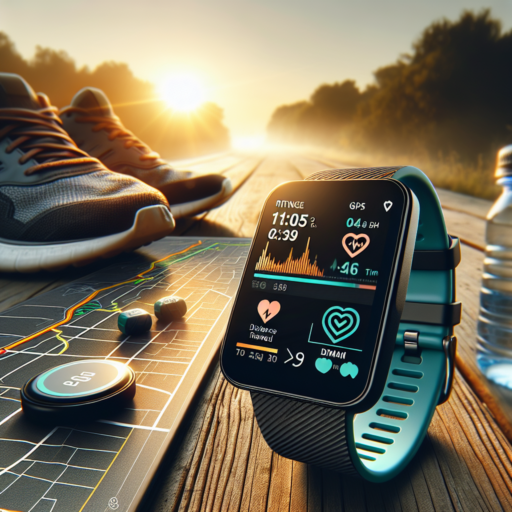Introduction to Tracking Running Distance
Understanding how to accurately track your running distance is pivotal for athletes and enthusiasts aiming to improve their performance and achieve their fitness goals. In recent years, technological advancements have made it easier than ever to record the miles you’ve covered. This introduction delves into the significance of tracking your running distance, offering insights into how doing so can be beneficial for your training regimen.
Tracking running distance not only helps in measuring your physical achievements but also plays a crucial role in planning your training sessions. By keeping an accurate account of the distance you run, you can set realistic goals, monitor your progress, and adjust your training plan accordingly. Whether you’re preparing for a marathon or trying to improve your cardiovascular health, understanding the distance you cover during each run is essential.
Moreover, tracking your distance encourages motivation and accountability. Seeing tangible evidence of your progress can boost your morale and encourage you to push your limits. It allows for a systematic approach to running, making your workouts more meaningful and goal-oriented. With a variety of tools available for tracking your runs, from sophisticated GPS watches to simple mobile apps, incorporating this practice into your routine has never been easier.
In conclusion, the art of tracking your running distance is a fundamental aspect of any runner’s journey. It not only enhances the quality of your training but also fosters a deeper connection with your running activities. As we explore the various methods and tools for distance tracking, it’s clear that this practice is invaluable for anyone looking to optimize their running experience.
Why It’s Important to Track Your Running Distance
Tracking your running distance is a crucial aspect of any runner’s routine, whether you are a beginner or an avid runner. The importance of keeping an eye on how far you run cannot be overstated, as it offers a clear picture of your progress, endurance, and overall running performance. Understanding your achievements and areas of improvement becomes straightforward when you consistently monitor your running distances.
One significant reason to track your running distance is to set realistic goals and benchmarks. When you know the distances you are covering, you can set ambitious yet achievable targets for yourself. This process not only keeps you motivated but also propels you forward in your running journey. Incremental increases in your running distance can lead to significant improvements in stamina and cardiovascular health over time. Moreover, tracking allows you to celebrate milestones, no matter how small, which can be incredibly rewarding and a key factor in maintaining a regular running habit.
Preventing overtraining is yet another vital reason for measuring your running distance. Overdoing it can lead to injury, burnout, and a decrease in performance, which is why it’s essential to have a clear understanding of your limits. By keeping track of how much you run, you can adjust your training schedule to ensure that you’re giving your body ample time to recover. This balanced approach not only enhances your physical well-being but also safeguards your mental health, making running a more enjoyable and sustainable part of your life.
Top Apps for Tracking Your Runs
Finding the right app to track your runs can be a game-changer for both novice runners and seasoned athletes. With the plethora of options available, it’s essential to choose an app that not only records your distance and pace but also provides insights that can help improve your performance. In the digital age, the ability to monitor your progress, set goals, and even compete with friends adds an extra layer of motivation that can make all the difference in your running journey.
Strava: The Social Network for Athletes
Strava is not just a run-tracking app; it’s a social network designed for athletes. Its unique feature set allows you to connect with friends, join challenges, and participate in community events, turning your runs into a shared experience. Strava’s extensive analytics go beyond basic tracking, offering deep insights into your performance, endurance, and how you stack up against fellow runners.
Nike Run Club: Personalized Coaching Plans
Nike Run Club takes a personalized approach to help you improve your running. With custom coaching plans that adapt to your goals and progress, it’s like having a personal coach in your pocket. The app’s motivational features, including cheers from friends and inspirational audio from elite athletes, add an emotional boost to your runs. Nike Run Club is ideal for runners looking to elevate their training with tailored guidance and community support.
MapMyRun: Versatile Tracking for All Runners
MapMyRun, by Under Armour, offers robust features for runners of all levels. Whether you’re mapping out new routes or keeping tabs on your shoes’ mileage, this app has you covered. Comprehensive tracking of pace, distance, and calories burned, coupled with audio feedback, ensures you’re always informed of your performance. For those who thrive on variety, NapMyRun’s ability to sync with various fitness devices and apps makes it a standout choice for integrating all aspects of your fitness regime.
Using a GPS Watch to Measure Your Running Distance
When it comes to tracking your running distance accurately, a GPS watch can be a game-changer. These sophisticated devices use Global Positioning System technology to track your movement, providing real-time data about your pace, distance, and sometimes even elevation. This not only helps in improving your performance over time but also ensures that you are training within your desired heart rate zones.
Benefits of Using a GPS Watch for Runners
- Accuracy in Distance Tracking: GPS watches use satellite data to measure your running distance precisely, unlike traditional pedometers that may not be as accurate.
- Monitoring Pace and Speed: By providing instant feedback on your pace, GPS watches allow runners to adjust their speed in real-time, helping to improve overall performance.
- Training Efficiency: With customizable training programs and the ability to store historical data, these watches can help runners analyze their progress and set realistic goals.
Moreover, for runners aiming to participate in races or those focused on improving their personal best times, the data captured by a GPS watch can be invaluable. It allows for a detailed analysis of each run, enabling you to pinpoint areas that need improvement such as pacing on inclines or consistency over long distances. By understanding your running patterns, you can make informed decisions about changes to your training regimen.
How to Estimate Running Distance with a Pedometer
Estimating your running distance with a pedometer is an invaluable technique for tracking your fitness progress and setting achievable goals. A pedometer, a device that counts each step you take, can be an excellent tool for runners who aim to incrementally increase their distance. However, converting steps into miles or kilometers requires understanding some basic concepts and setting up your device accurately.
Calibrate Your Pedometer
Before you can accurately estimate the distance you’ve run, it’s essential to calibrate your pedometer for your step length. Most pedometers will ask for your step length during the setup process. You can determine this by measuring the distance of several steps you take and calculating the average. Once calibrated, your pedometer will more accurately translate your step count into the distance traveled.
Understand the Metrics
Different pedometers display your activity in various metrics — steps, calories, and distance. Focus on the distance metric for estimating your running distance. Keep in mind that the accuracy of the distance depends on the calibration of your step length. Also, remember that terrain, stride variations, and pace can affect the count, introducing a small margin of error in the data presented.
To refine your distance estimations, periodically review and adjust the step length in your pedometer settings. This adjustment accounts for improvements in your running efficiency or changes in your average stride length. By keeping these elements in check, you can rely on your pedometer to provide a reasonable estimate of the distance you run, aiding in setting realistic fitness goals and monitoring your progress over time.
Advantages of Tracking Distance Through Smartphones
Smartphones have revolutionized many aspects of our lives, not least of which is the ability to track our movements, offering a window into our physical activity and travel. With built-in GPS and various health and tracking apps, these devices offer substantial advantages for users looking to monitor their distance traveled, whether for fitness goals, travel logs, or safety reasons.
Enhanced Fitness Tracking
Improving personal fitness has never been easier, thanks to the ability of smartphones to track distance traveled. For those committed to running, cycling, or walking, this tracking facilitates detailed insights into their workouts, allowing for the setting of precise goals and the monitoring of progress over time. This real-time feedback encourages consistency and improvement in physical activities, contributing significantly to one’s health and well-being.
Accurate Travel Logs
The convenience of having your travel distance tracked on your smartphone cannot be overstated for those who love to explore or need to log miles for work. The accuracy of GPS technology ensures that every mile is accounted for, making it an invaluable tool for adventurers and professionals alike. This data can be used for reimbursements, travel allowances, or simply to keep a personal record of your travels.
Enhanced Safety Measures
Lastly, the safety advantages of distance tracking cannot be ignored. Not only can friends and family keep an eye on their loved ones during outdoor activities, but in case of an emergency, the exact location can be shared with emergency services, potentially saving lives. This adds an invaluable layer of security for those venturing into less populated or secure areas.
Understanding the Accuracy of Different Distance Tracking Methods
In the realm of distance tracking, accuracy is pivotal for both amateurs and professionals alike. Whether it’s for athletic training, navigational purposes, or scientific research, the method chosen to measure distance can significantly impact the results. As technology advances, so do the options for tracking, each with its own set of advantages and limitations.
GPS-Based Tracking
Global Positioning System (GPS) technology is widely regarded for its precision in outdoor environments. This method relies on a network of satellites to determine location data, which can then be used to calculate distances traveled. However, the accuracy of GPS can be affected by several factors, including signal interference from tall buildings or dense foliage, and the quality of the GPS receiver itself. Despite these potential limitations, GPS is often the go-to choice for activities like running, cycling, and hiking, where broad-scale accuracy is essential.
Pedometer and Step Counter Apps
Another commonly used method involves pedometers and smartphone step counter apps. These tools estimate distance based on the user’s step count, multiplying the number of steps by an average step length. While incredibly convenient and accessible, the accuracy of pedometers and step counters can vary widely. The precision depends on factors such as the user’s walking or running stride length and the algorithm used by the device or app. For casual fitness tracking, this method may be sufficient, but it may not provide the level of detail required for more rigorous applications.
No se han encontrado productos.
Tips to Increase the Accuracy of Your Distance Tracking
Enhancing the precision of your distance tracking can significantly impact your fitness journey or any related activity that relies on accurate measurements. Whether you’re a professional athlete or a casual walker, understanding how to improve these metrics can lead to more efficient training sessions and better tracking of your progress.
Utilize High-Quality Tracking Devices
One of the first steps in increasing the accuracy of your distance tracking is to invest in high-quality tracking devices. Opt for devices with advanced GPS technology, as they tend to offer more precise readings compared to basic models. Ensure that your device is regularly updated and calibrated to maintain its accuracy. Devices that allow for multi-GNSS support (access to multiple satellite systems) can also enhance precision, especially in challenging environments.
Calibrate Your Device Regularly
Regular calibration of your tracking device is crucial. For those using smartphones or smartwatches, many of these devices have built-in calibration tools. Follow the manufacturer’s instructions for calibration, which might include walking or running a known distance or performing specific actions. Calibration ensures that the device’s sensors are accurately measuring your movements, significantly improving the overall reliability of your distance tracking.
Combine with Other Tracking Methods
To maximize the accuracy of your distance tracking, consider using multiple tracking methods in conjunction. Combining the use of a high-quality GPS device with smartphone apps that are designed for distance tracking can offer a more comprehensive view of your efforts. Additionally, using landmarks and pre-measured routes as references can help validate the data collected by your electronic devices, ensuring you’re getting the most accurate readings possible.
Integrating Distance Tracking Data with Fitness Goals
Integrating distance tracking data into your fitness regiment is a vital step for anyone looking to achieve their fitness goals effectively. The marriage between distance metrics and personal fitness targets can create a more structured and insightful training plan. By understanding how much ground you’ve covered, whether by running, walking, or cycling, you can tailor your workouts more precisely to suit your endurance and strength-building needs.
Why Distance Tracking Matters in Fitness
Distance tracking serves as a quantitative measure of progress not just for runners but for anyone interested in maintaining or improving cardiovascular health. Knowing the specifics of the distance you’ve managed helps in setting realistic and challenging goals. It compels individuals to push their limits gradually, ensuring continuous improvement while minimizing the risk of injury. Moreover, this data can assist in achieving a fine balance between workout intensity and recovery, an essential aspect of any successful fitness plan.
Utilizing Distance Data to Enhance Your Workout
Once you’ve gathered distance tracking data, the real magic happens when you integrate this information with your fitness objectives. For starters, assess your current capabilities and compare them with your goals. If your aim is to increase stamina, for example, gradually boosting the distance of your runs each week could be a beneficial strategy. Conversely, if improving speed is your goal, incorporating short, high-intensity sprints over shorter distances can be effective. This data-driven approach ensures that every workout is purposeful and aligned with your ultimate fitness aspirations.
Remember, integrating distance tracking data with your fitness goals is not about obsessing over numbers but about understanding your performance levels and using that insight to guide your training decisions. This harmony between digital tracking and personal health objectives paves the way for smarter, more effective fitness routines that can lead to substantial improvements in physical well-being.
Conclusion: Maximizing the Benefits of Tracking Your Running Distance
Tracking your running distance isn’t just about documenting miles; it’s a pathway to understanding your performance, setting realistic goals, and safeguarding your health. By consistently keeping track of your progress, you craft a detailed roadmap of your journey towards becoming a more efficient runner. This attention to detail allows for tailored adjustments in your training, ensuring that each step taken is in the right direction towards your personal benchmarks.
Integrating technology in your running regimen, like using smartwatches or apps, offers an insightful look into various metrics that contribute to your overall performance. These devices do more than measure distance; they analyze your pace, elevation gains, and even your heart rate, providing a holistic view of your running health. By leveraging this data, you can fine-tune your training, focus on areas that need improvement, and celebrate the milestones reached along the way.
Moreover, understanding the importance of rest and recovery is crucial in maximizing the benefits of tracking your running distance. By monitoring the miles, you also learn when to push forward and when to pull back, preventing overtraining and reducing the risk of injury. This balance ensures that each run contributes positively to your physical fitness and overall well-being, helping you to sustain a healthy and enjoyable running experience for years to come.



